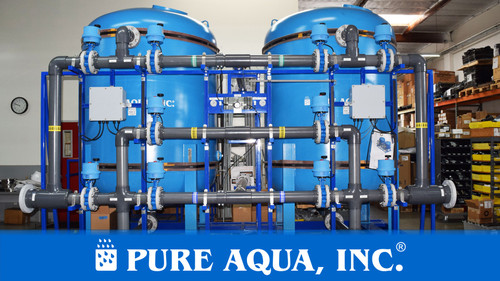Reversing the flow is where we need to apply an enormous energy to put pressure on the water to separate permeate from the concentrate in the semi permeable membrane. Energy efficient reverse osmosis requires high pressure pumps and these pumps needs big motors to do the job especially for high TDS water like Sea Water.
[custom-specifications]
Brackish or seawater have high salinity and TDS ranges anywhere from 5,000 ppm to 45,000 ppm and at this quality of water we need to use pressure as high as 1,000 psi (69 bar) to drive the water across a thin-film composite membrane specifically designed for sea water. Depending on the water flow rate, the SWRO system will need high water pressure that carry over into the reject stream. This high pressure is being captured by using an ERD (Energy Recovery Devices) that puts back that energy into the system and reducing the required pump horse power on the main pump. These ERDs can be (Turbochargers or Pressure Exchange) that are added into the system and cuts required pump HP rating for up to 50%. This results to lower cost of manufacturing an RO system as well as lower operational cost since these ERDs don’t normally need power to function and it only runs thru the excess pressure of the water. This also leads to lower cost of water production per unit volume and increases the ROI on this types of water filtration equipment.
[/custom-specifications]
[custom-features]
Energy efficient reverse osmosis systems are now being used in all applications where RO filtration is needed. In fact, some RO projects even involve just a replacement of the membranes to decrease the energy requirement of the old RO skid and reduce the daily operational expense and not to replace the whole system altogether.
RO membrane manufacturers also do their contribution on offering energy efficient TFC (Thin Film Composites) membranes to the market. They have developed these by using different sizes of feed spacers thickness or the overall active area of the product. With these adjustments the whole system now needs lesser water pressure to drive the water across and this results to lower pump rating needed which equates to overall energy requirement reduction.
[/custom-features]
[custom-usage]
Energy Efficient Reverse Osmosis systems were developed to effectively filter-off unwanted dissolved solids in the water for different applications. Osmosis works as a natural process wherein water flows from higher salt concentration to lower salt concentration through a semi permeable membrane without any energy applied.
[/custom-usage]
-
High efficiency
I will recommend this company for anybody who is looking for energy efficient RO systems
- Related Project1:
- https://pureaqua.com/industrial-swro-plant-136000-gpd-maldives/
- Related Project2:
- https://pureaqua.com/twin-alternating-seawater-system-with-common-pre-treatment-150-m3-day-belize/
- Related Project3:
- https://pureaqua.com/containerized-double-pass-swro-for-construction-site-8000-gpd-trinidad/
- Related Project4:
- https://pureaqua.com/commercial-reverse-osmosis-machine-32000-gpd-indonesia/
 ENGLISH
ENGLISH ESPAÑOL
ESPAÑOL العربية
العربية PORTUGUÉS
PORTUGUÉS FRANÇAIS
FRANÇAIS













